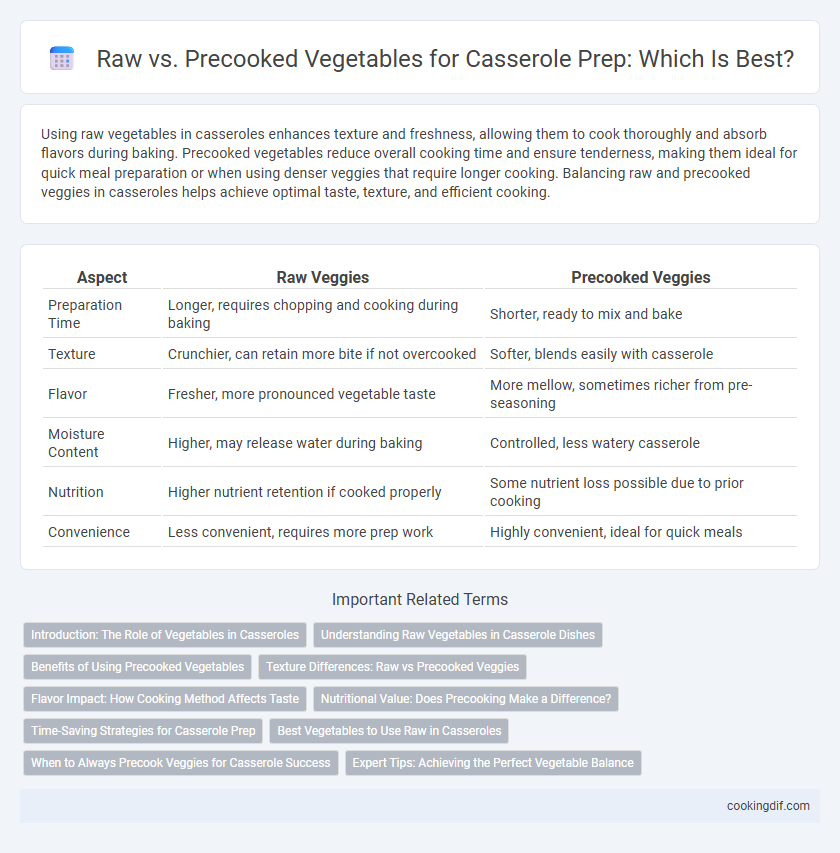Using raw vegetables in casseroles enhances texture and freshness, allowing them to cook thoroughly and absorb flavors during baking. Precooked vegetables reduce overall cooking time and ensure tenderness, making them ideal for quick meal preparation or when using denser veggies that require longer cooking. Balancing raw and precooked veggies in casseroles helps achieve optimal taste, texture, and efficient cooking.
Table of Comparison
| Aspect | Raw Veggies | Precooked Veggies |
|---|---|---|
| Preparation Time | Longer, requires chopping and cooking during baking | Shorter, ready to mix and bake |
| Texture | Crunchier, can retain more bite if not overcooked | Softer, blends easily with casserole |
| Flavor | Fresher, more pronounced vegetable taste | More mellow, sometimes richer from pre-seasoning |
| Moisture Content | Higher, may release water during baking | Controlled, less watery casserole |
| Nutrition | Higher nutrient retention if cooked properly | Some nutrient loss possible due to prior cooking |
| Convenience | Less convenient, requires more prep work | Highly convenient, ideal for quick meals |
Introduction: The Role of Vegetables in Casseroles
Vegetables such as carrots, bell peppers, and zucchini provide essential nutrients and texture to casseroles, making their preparation critical to the dish's overall taste and consistency. Raw veggies offer a fresh, crunchy bite and retain more vitamins, but require longer cooking times to soften properly within the casserole. Precooked vegetables, including steamed broccoli or sauteed mushrooms, integrate faster and enhance flavor depth while ensuring even heat distribution throughout the bake.
Understanding Raw Vegetables in Casserole Dishes
Raw vegetables in casserole dishes offer a firmer texture and retain more nutrients during cooking compared to precooked veggies. Incorporating firm vegetables such as carrots, broccoli, or bell peppers ensures they soften appropriately while absorbing flavors without becoming mushy. Properly managing moisture content and cooking time is essential to balance texture and flavor when using raw vegetables in casseroles.
Benefits of Using Precooked Vegetables
Using precooked vegetables in casseroles enhances texture by preventing excess moisture that raw veggies release during baking, resulting in a firmer, more appetizing dish. Precooked vegetables also reduce overall cooking time, allowing flavors to meld more efficiently and ensuring even heat distribution throughout the casserole. This method preserves nutrient content better than prolonged baking, maintaining essential vitamins and minerals for a healthier meal.
Texture Differences: Raw vs Precooked Veggies
Raw vegetables in casseroles maintain a firmer, crunchier texture after baking, offering a distinct contrast to soft, tender ingredients. Precooked vegetables tend to soften significantly, blending seamlessly into the dish but potentially yielding a mushier consistency. Choosing between raw and precooked veggies directly affects the casserole's overall mouthfeel and layering of textures.
Flavor Impact: How Cooking Method Affects Taste
Using raw vegetables in casseroles preserves a fresher, more robust flavor, as they release natural juices during baking that enhance the dish's overall taste. Precooking vegetables softens their texture and mellows their flavors, leading to a smoother, more integrated flavor profile but possibly reducing the vibrancy of individual ingredients. Choosing between raw and precooked veggies affects the casserole's texture and flavor complexity, with raw vegetables offering a bright, pronounced taste while precooked options contribute to a harmonious blend.
Nutritional Value: Does Precooking Make a Difference?
Precooking vegetables for casseroles can alter their nutritional content, often reducing water-soluble vitamins like vitamin C and some B vitamins due to heat exposure. Raw vegetables retain more nutrients but may require longer cooking times during baking to become tender. Choosing between raw and precooked veggies depends on balancing nutrient preservation with desired texture and cooking convenience in casserole preparation.
Time-Saving Strategies for Casserole Prep
Using precooked vegetables in casseroles significantly reduces cooking time by eliminating the need for extended baking or simmering to soften raw veggies. Precooked veggies ensure even texture and faster heat penetration, enabling quicker meal prep and reliable results. Incorporating raw vegetables requires longer baking times to achieve tenderness, which can extend overall cooking duration.
Best Vegetables to Use Raw in Casseroles
Peppers, onions, and zucchini are ideal raw vegetables for casseroles due to their firm texture and ability to retain moisture during baking. Raw carrots and green beans also work well, offering a slight crunch and vibrant color without overcooking. Using these raw veggies ensures a fresh, crisp contrast within the creamy and soft components of traditional casseroles.
When to Always Precook Veggies for Casserole Success
Dense vegetables like carrots, potatoes, and broccoli must always be precooked for casseroles to ensure even cooking and maintain a tender texture. Precooking also reduces excess moisture from veggies like mushrooms and spinach, preventing a soggy casserole. Delicate vegetables such as bell peppers and zucchini can be added raw when thinly sliced, but precooking guarantees consistent flavor and optimal texture in the finished dish.
Expert Tips: Achieving the Perfect Vegetable Balance
Using raw vegetables in casseroles preserves their natural texture and fresh flavor, while precooked veggies offer consistent tenderness and reduce overall cooking time. Experts recommend lightly sauteing or blanching raw vegetables to enhance flavor and ensure even cooking, especially for dense or watery varieties like carrots and zucchini. Balancing raw and precooked vegetables optimizes moisture control and texture, creating a harmonious casserole with perfectly cooked, flavorful layers.
Raw vs Precooked Veggies for casserole prep Infographic

 cookingdif.com
cookingdif.com